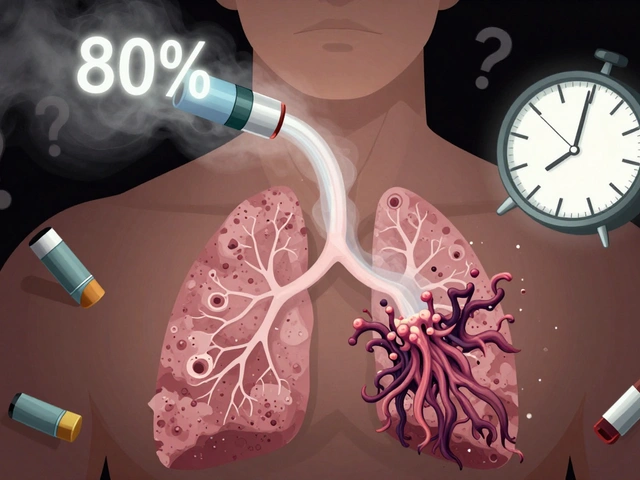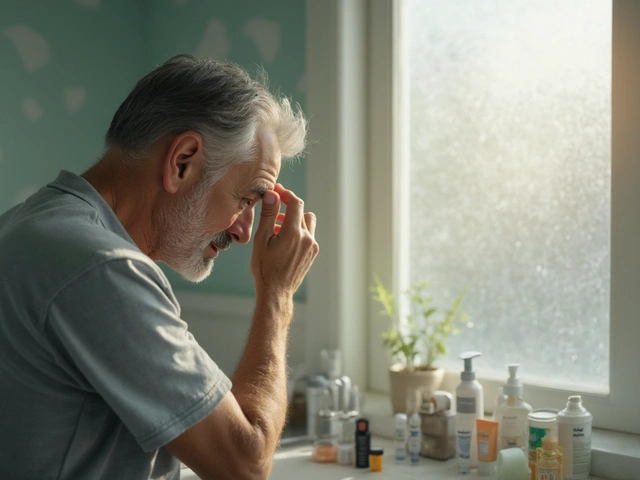GERD is a chronic condition where stomach acid frequently flows back into the esophagus, causing heartburn and other uncomfortable symptoms. When you reach for a can of soda, the carbonated beverage is any drink infused with dissolved carbon dioxide, creating bubbles and a slightly acidic environment. That fizz can set off a chain reaction in the digestive tract, turning a casual sip into a flare‑up. Below is a quick rundown of what you need to know.
- Carbonation can relax the lower esophageal sphincter, letting acid escape.
- Acidic pH and caffeine intensify heartburn for many sufferers.
- Not all fizzy drinks are equal - sugar, caffeine, and acidity matter.
- Simple swaps and timing tricks can cut down reflux episodes.
- Seek medical advice if symptoms persist despite lifestyle tweaks.
What Happens Inside When You Drink Something Fizzy?
To understand why the bubbles are a problem, start with the lower esophageal sphincter is a circular muscle at the junction of the esophagus and stomach that normally stays closed to keep acid in the stomach. Carbon dioxide (CO₂) dissolved in a drink creates pressure that can temporarily lower the tone of this muscle. When the sphincter relaxes, even a small amount of stomach acid (hydrochloric acid with a pH of 1‑2) can splash back into the esophagus.
The esophageal lining isn’t built to handle that acidity. The result is the classic burning sensation known as heartburn, plus possible regurgitation, throat irritation, or a lingering sour taste.
Key Ingredients That Make Fizzy Drinks a GERD Trigger
Not every carbonated drink acts the same. Three main factors dictate how harsh a sip will be:
- Carbonation level - Higher CO₂ pressure means more stomach distension and a greater chance of sphincter relaxation.
- Acidity (pH) - Most sodas sit around pH 2.5‑3, comparable to orange juice. The more acidic the drink, the more likely it is to irritate the esophagus if reflux occurs.
- Additional stimulants - Caffeine and sugar can both increase gastric acid production and lower sphincter pressure.
Below is a quick cheat‑sheet that breaks down the most common fizzy drinks you’ll find at the shop.
| Drink Type | Typical Sugar (g) | Caffeine (mg) | pH Range | Carbonation (g/L) | GERD Impact Rating* |
|---|---|---|---|---|---|
| Regular Cola | 39 | 34 | 2.5‑3.0 | 5‑6 | High |
| Diet Cola | 0 (artificial sweetener) | 34 | 2.5‑3.0 | 5‑6 | High |
| Sprite / Lemon‑Lime Clear Soda | 38 | 0 | 2.6‑3.2 | 5‑6 | Medium‑High |
| Sparkling Water (plain) | 0 | 0 | 5‑7 (neutral) | 6‑7 | Low‑Medium |
| Flavored Sparkling Water | 0‑2 (natural flavor) | 0 | 4‑5 | 6‑7 | Medium |
| Kombucha | 2‑4 (fermented sugars) | 0‑10 | 3.0‑3.5 | 4‑5 | Medium |
*Ratings are based on clinical observations and patient reports: High (most likely to trigger symptoms), Medium (moderate risk), Low (least likely).
Practical Ways to Enjoy Fizzy Without the Fire
If you love the sparkle but not the burn, try these evidence‑backed tricks:
- Choose low‑acid, caffeine‑free options. Plain sparkling water or lightly flavored seltzer (with a splash of citrus) usually scores low on the impact rating.
- Mind the timing. Drink fizzy beverages at least two hours after a meal. An empty stomach reduces the volume of acid that can be pushed up.
- Control portion size. A half‑can (about 200ml) delivers far less CO₂ pressure than a full 355ml can.
- Stay upright. Sitting or standing for 30minutes after sipping helps gravity keep the sphincter shut.
- Dilute. Mix soda with sparkling water (1:1). The carbonation stays, but the acidity and sugar drop sharply.

Beyond Beverages: Lifestyle Tweaks That Complement Your Diet
Fizzy drinks are just one piece of the puzzle. Combine the above beverage strategies with these broader habits for a bigger symptom reduction:
- Weight management. Excess abdominal fat puts pressure on the stomach, encouraging reflux.
- Clothing choice. Tight belts or waistbands can push the stomach upward and trigger acid escape.
- Meal composition. Limit high‑fat, fried, or spicy foods that relax the sphincter.
- Smoking cessation. Nicotine directly weakens the lower esophageal sphincter.
- Sleep position. Elevate the head of the bed 6‑8inches or sleep on the left side to reduce nighttime reflux.
When to Call a Doctor
Even with perfect diet tweaks, some people experience persistent symptoms. Consider professional advice if you notice any of the following:
- Heartburn more than three times a week.
- Difficulty swallowing, feeling of food stuck, or frequent choking.
- Unexplained weight loss or anemia.
- Chest pain that mimics a heart attack (always get it checked).
Doctors may prescribe proton pump inhibitors (PPIs) or recommend an endoscopy to assess esophageal damage.
Frequently Asked Questions
Can sparkling water still cause reflux?
Yes, but the risk is much lower than with sugary sodas. The main issue with sparkling water is the carbonation pressure, which can relax the sphincter briefly. Drinking smaller sips and staying upright minimizes the effect.
Do diet sodas aggravate GERD more than regular sodas?
Both can be problematic. Diet sodas replace sugar with artificial sweeteners, which don’t increase acid production, but they still contain caffeine and high acidity. The overall impact is similar, so it’s safer to choose caffeine‑free, low‑acid alternatives.
Is it okay to have a soda after a meal if I have GERD?
It’s best to avoid it for at least two hours after eating. A full stomach already pushes acid upward; adding carbonation can tip the balance and cause a flare‑up.
Can reducing soda intake improve my GERD medication effectiveness?
Absolutely. Less acid‑triggering food and drink means the medication doesn’t have to work as hard, leading to better symptom control and possibly lower doses over time.
Are there any natural remedies that counteract the effect of carbonation?
Chewing gum after a meal can increase saliva production, which neutralizes acid. Also, a teaspoon of apple‑cider vinegar diluted in water (if you tolerate it) may help balance stomach pH for some people, though evidence is mixed.





diego suarez
September 28, 2025 AT 16:12When you gulp down a soda, the carbon dioxide creates pressure that can temporarily relax the lower esophageal sphincter. This little tug‑of‑war lets stomach acid slip upward more easily than with still water. The effect is subtle at first, but for GERD sufferers even a minor relaxation can trigger a flare‑up. So the fizz isn’t just sparkle; it’s a mechanical push on the gate that keeps acid in.
Brian Lancaster-Mayzure
October 5, 2025 AT 14:52Timing matters just as much as the drink itself. If you wait at least two hours after a meal before reaching for a carbonated beverage, the stomach isn’t full and the pressure on the sphincter is lower. This simple habit can cut down the number of heartburn episodes without giving up the occasional soda.
Erynn Rhode
October 12, 2025 AT 13:32There’s a cascade of physiological events that starts the moment the carbonated liquid hits your stomach, and it’s worth unpacking each step. First, the dissolved CO₂ creates bubbles that increase intragastric volume, stretching the stomach wall. That stretch activates mechanoreceptors, signalling the brain that the stomach is full, which in turn can relax the lower esophageal sphincter (LES). A relaxed LES is essentially an open door, allowing acidic gastric contents to reflux into the esophagus.
Second, many sodas are acidic themselves, with a pH around 2.5 to 3, adding an extra acid load that the esophageal lining must buffer. The combination of external pressure from carbonation and internal acidity creates a perfect storm for GERD symptoms.
Third, caffeine, present in many colas, stimulates gastric acid secretion, pushing the overall acidity higher. Even diet sodas, despite lacking sugar, retain caffeine and acidity, so they’re not exempt from the issue.
Beyond the chemistry, habitual consumption can lead to desensitization of the esophageal mucosa, making it more vulnerable over time. This is why patients often report that a small increase in soda intake suddenly triggers more severe heartburn.
On the practical side, diluting soda with sparkling water halves the CO₂ concentration while preserving the fizz, which can be a useful compromise.
Finally, staying upright after drinking helps gravity keep the LES closed, reducing the chance of reflux. ⭕️
Rhys Black
October 19, 2025 AT 12:12It’s almost comical how the modern soda empire glorifies a liquid that essentially sabotages our digestive architecture. The cultural narrative that “fizzy is fun” ignores the physiological tyranny these beverages exert on the LES. While some preach moderation, the marketing machine pushes endless consumption, and the body pays the price. If we truly cared about health, we’d see a shift from sugar‑laden carbonated drinks to genuinely nourishing alternatives.
xie teresa
October 26, 2025 AT 09:52I hear you on the frustration with the soda industry’s hype. It’s hard to feel heard when the market keeps feeding us these triggers. For those dealing with GERD, focusing on small, sustainable swaps can feel empowering amidst the noise. Remember, every reduced sip is a step toward calmer nights and fewer burn‑outs. You’re not alone in navigating this fizzy maze.
Srinivasa Kadiyala
November 2, 2025 AT 08:32From a physicochemical perspective, the pH of most commercial colas hovers around 2.5‑3.0, which is comparable to gastric acid itself; this acidity compounds the reflux potential when the sphincter relaxes. Moreover, the carbonation level-typically 5‑6 g/L-adds an additional hydrostatic component that can transiently lower LES tone. In essence, you are introducing a double assault: chemical acidity plus mechanical pressure.
Alex LaMere
November 9, 2025 AT 07:12That’s accurate.
mitch giezeman
November 16, 2025 AT 05:52Choosing low‑acid, caffeine‑free sparkling water can keep the fizz without the burn. Look for brands that list a neutral pH (around 5‑7) and minimal carbonation pressure; they’re often the safest bets for GERD patients.
Kelly Gibbs
November 23, 2025 AT 04:32Makes sense, I’ll try that.
Stephanie Pineda
November 30, 2025 AT 03:12Ah, the sweet‑silly dance of bubbles that love to throw a party right in your esophagus-what a delightful disaster!
Anne Snyder
December 7, 2025 AT 01:52Indeed, the interplay of osmolarity, carbonation gradients, and gastro‑esophageal reflux index (GERI) creates a micro‑environment where the mucosal barrier is constantly challenged. Leveraging low‑glycemic, low‑CO₂ formulations can attenuate the GERI score, thereby reducing symptomatic episodes.
Vani Prasanth
December 14, 2025 AT 00:32In many countries, traditional fermented drinks like kefir or kombucha have lower carbonation and different acid profiles, which can be gentler on the stomach. It’s worth exploring these local options if you’re looking for a fizz that’s less aggressive.
Maggie Hewitt
December 20, 2025 AT 23:12Oh sure, because everyone’s first thought when they hear “fermented” is “let’s add more acid and bubbles,” right? 🙃